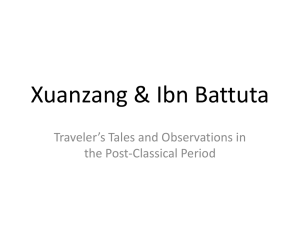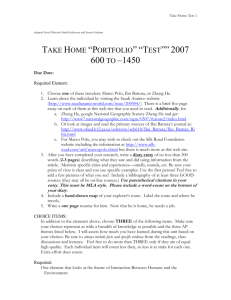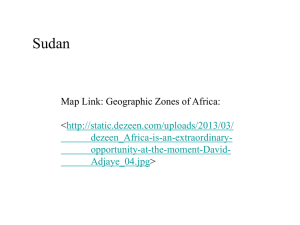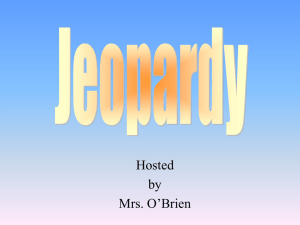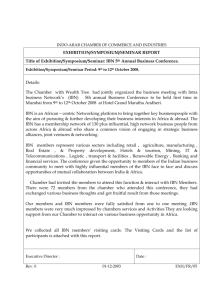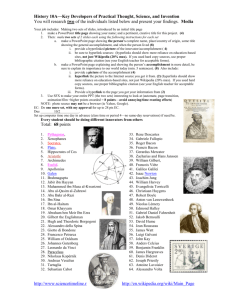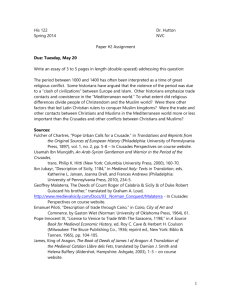Educator's Guide
advertisement
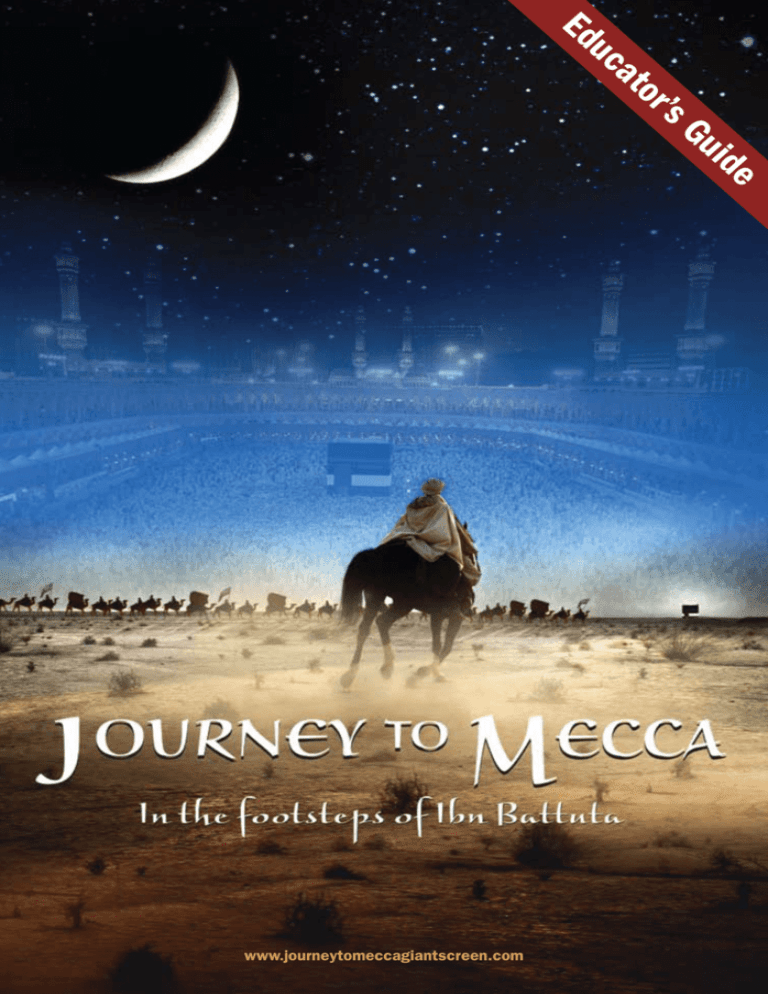
at uc Ed ’s or e id Gu www.journeytomeccagiantscreen.com Journey to Mecca: In the footsteps of Ibn Battuta Ibn Battuta is considered one of the world’s greatest travelers. During the 14th century, he traveled an estimated 75,000 miles across most of the Eastern Hemisphere, three times farther than Marco Polo, in search of knowledge and for the love of travel. In today’s world, this encompasses over 40 countries. To share the learning and research so highly valued by Islamic culture, the Sultan of Morocco, Abu Inan Faris, wanted Ibn Battuta’s worldwide travels recorded and published when he returned home to Morocco after almost 30 years. Ibn Juzayy, a Moroccan Court Secretary, was appointed to write down Ibn Battuta’s reminiscences. His travel journal, The Rihla (formally titled A Gift to the Observers Concerning the Curiosities of the Cities and the Marvels Encountered in Travels), documents this enormous achievement and is the inspiration for the film. Ibn Battuta’s journey gives us a first-hand I set out alone, having neither account of life in the 14th-century Muslim world, while offering a glimpse fellow-traveler in whose of the world through the perspective of an educated “cosmopolitan.” The companionship I might find original book, handwritten in Arabic, can be viewed today at the National cheer, nor Caravan whose party Library in Paris. I might join, but swayed by an overmastering impulse within me and a desire long-cherished in my bosom. —Ibn Battuta, 1355 C.E. The early 14th century was a favorable time for a Muslim traveler. It was nearing the end of the Golden Age of Islam, one of the great explosions of scientific and cultural achievement in world history. Enormous opportunities for long-distance travel began to exist in the 13th century after the Mongols and other nomadic groups established large, stable empires in Eurasia that facilitated travel, trade and cultural exchange. The expanding world of Islam, or Dar al-Islam, was an extension of these earlier political and cultural structures and made travel on this scale possible for almost the first time in world history. Caravans and sea lanes created transportation and communication networks that stretched across the Eastern Hemisphere. Afroeurasian towns and cities were regularly visited by merchants, traders, diplomats, doctors, artists, craftsmen, scholars and pilgrims carrying goods and ideas. All of this facilitated the exchange of goods and ideas on a scale not seen previously in world history. Unlike today, when your affiliation is with your country of origin, Ibn Battuta was a citizen of the Dar al-Islam. Ibn Battuta saw this world almost in its entirety. Just about everywhere he traveled, he found others who shared his culture, languages, faith or values. As an educated man with legal expertise, he enjoyed hospitality, companionship and offers of employment throughout the Islamic world. This interconnected world not only included Muslims but also Christians, Jews, Buddhists and Hindus. Indeed, Ibn Battuta was far ahead of his time; he was a true global citizen. Journey to Mecca dramatizes the 5,000-mile journey Ibn Battuta made in 1325 and 1326 from his hometown of Tangier, Morocco, to reach Mecca, in what is now the Kingdom of Saudi Arabia, to perform the Hajj. During this perilous and awe-inspiring 18-month pilgrimage, he encountered numerous obstacles as he was attacked by bandits, dehydrated by thirst, rescued by Bedouins and forced to retrace his route due to war along the Red Sea. Joining the legendary Damascus Caravan with thousands of pilgrims bound for Mecca, he completed the final leg of what would be his first of six journeys to Mecca. When he arrived in Mecca he was a man transformed. The film invites us to experience the Hajj as Ibn Battuta did over 700 years ago and then transitions to the Hajj as it is performed today. Journey to Mecca marks the first time an IMAX camera has captured an aerial view of the Hajj and been admitted to the most sacred sanctuary of Islam — the Grand Mosque in Mecca. “The genesis of the film was to tell the remarkable story of Ibn Battuta, promote a better understanding of Islam in the West, and to present the heart of Islam to the Muslim world.” ­The Producers of Journey to Mecca 2 Journey to Mecca Educator’s Guide ©2009 SK Films Inc. Suggested Pre- and Post-Visit Questions Before Viewing Activate Prior Knowledge and Provide Context Background on the Film: •The film is a dramatized representation of what is recorded in The Rihla, which itself is a collection of Ibn Battuta’s reminiscences. •The Highwayman is a character created to represent a variety of people Ibn Battuta would have encountered on his travels. For literary purposes, they are bundled into one person. •The footage will sometimes shift between the modern Hajj and Ibn Battuta’s Hajj; students should look for visual clues to tell the time period, and note the differences and similarities. •Journey to Mecca is a Cosmic Picture/SK Films Production and is presented by the King Abdulaziz Public Library and the King Faisal Center for Research and Islamic Studies. Who was Ibn Battuta? •What did he do? •How do we know about him? •What is The Rihla? •What do you think Ibn Battuta must have been like to have traveled so far, for so long, by himself? •Predict and explain, in words or pictures, what you think you will see in the film. •Why do you think Ibn Battuta said, “I believe those braving the greatest risk receive the greatest reward”? Do you agree? Why? Why Travel? •Why are travelers important? What role do they play in society? •How do travelers spread ideas and knowledge? •To be a good source of information, what skills must a traveler possess? •How did Ibn Battuta travel to Mecca in 1325? •Where else did Ibn Battuta travel in Afroeurasia? •Through what kinds of environments did he travel? •What difficulties did he face? What are the Five Pillars of Islam? •What is the Hajj? •What happens during the Hajj? •What other pilgrimages exist? 3 Journey to Mecca Educator’s Guide After Viewing Think Critically about the Film Critical Thinking Probe for Students •Now that you have seen the film, why do you think Ibn Battuta said, “I believe those braving the greatest risk receive the greatest reward”? •Do you think he did “brave the greatest risk”? What rewards did he receive for his travels? •Reread the predictions and explanations you made about Ibn Battuta and about his travels before viewing the film. How did the film SUPPORT, EXTEND OR CHALLENGE your ideas about Islam, the 14th century and/or a traveler such as Ibn Battuta? Geography: People and Places of Travel •What surprised you about the physical environments you saw in the film? •What resources, scientific and other tools and types of transportation did Ibn Battuta use during his first journey to Mecca? Do we use the same items today? If not, how do we meet our needs to get from place to place? •What do you think about caravan travel? What challenges would a traveler face today that are similar to Ibn Battuta’s? What challenges would be different? •In what ways do you think Ibn Battuta might have been shaped by the people, events, places and ideas he encountered, for example, in Egypt, Damascus, Arabia, etc.? In what ways do you think Ibn Battuta might have shaped the people and places he encountered? •How do you think his new understandings helped him on his continued travels? World Religions: Islam and the Hajj •How did Ibn Battuta’s Muslim faith influence his life? In what ways did the Five Pillars of Islam affect his travels? •What surprised you about the Hajj? •What is the same about the Hajj today and Ibn Battuta’s Hajj? What has changed? Why do you think these changes were made? Do you think the changes alter the experience of the Hajj? Why? •Have you or someone you know made a pilgrimage? Compare it with Ibn Battuta’s. •What are the similarities and differences between some of the fundamental beliefs of world religions such as Christianity, Judaism and Islam? ©2009 SK Films Inc. Glossary of Terms Abraham – An important early prophet accepted by Judaism, Christianity and Islam. Astrolabe – A historical navigational instrument used by explorers to determine direction by the placement of the sun, moon and planets. Bedouin – An Arab belonging to any of the nomadic tribes of the Arabian, Syrian, Nubian or Sahara deserts. Common Era (C.E.) – The period beginning with the year traditionally considered the birth of Jesus. Also “Current Era” or “Christian Era.” This notation is preferred by non-Christians to “A.D.,” or “Anno Domini.” Astrolabe Dar al-Islam – Lands governed according to the laws of Islam. Literally translated it means “the home of Islam.” Five Pillars of Islam – The Five Pillars consist of five ritual duties: Shahadah - the confession of faith; Salat - prayer; Sawm Ramadan the fast of the month of Ramadan; Zakat - alms-giving; and Hajj - the pilgrimage to Mecca. Hajj – The pilgrimage to Mecca and the fifth pillar of Islam. In 628 C.E., the Prophet Muhammad set out on a journey to Mecca — the first Hajj — with 1,400 of his followers. Today, around 3 million perform the Hajj each year. Pilgrimage Hospitality – Friendly reception of guests or strangers. Islam – The religious faith of Muslims who believe that there is but one God and that God revealed the Qu’ran to the Prophet Muhammad. The Arabic word for God is Allah. Islam began in Arabia and is the second largest religion in the world, with more than 1 billion followers. Ka’bah – The holiest site of Islam, regarded by Muslims as the House of God built by the Prophet Abraham. It is a cube-shaped structure located within the mosque at Mecca. Pilgrims performing the Hajj circle the Ka’bah, and Muslims all over the world face toward the Ka’bah during prayer. Samoom Ka’bah Mamluks – Captured as non-Muslim boys by Muslim rulers in various parts of the Dar al-Islam, the mamluks were brought up to be Muslim soldiers. Eventually, they seized power for themselves in some areas, including Egypt, during the time of Ibn Battuta’s travels. Mecca – A city in Saudi Arabia that is home to the Ka’bah, the holiest site in Islam and the destination of the Hajj. Medina – The city in Saudi Arabia where Muhammad is buried. Many pilgrims visit the mosque here after completing the Hajj. Mosque – A building that is dedicated to Muslim worship. Muhammad – (c. 570–632 C.E.) Muhammad is a central human figure in Islam, revered as a prophet who communicated with God and recorded Islam’s holiest book, the Qu’ran, regarded by Muslims as the word of God. Mutawwifs – Guides for the Hajj. They are called muallims in India. Navigation – The science of finding one’s way. Pilgrimage – A journey made for spiritual reasons, often to a place of special religious significance. Primary Source – Primary sources are documents or objects that have survived from the time under study, such as letters or articles of clothing, which give an insider’s perspective on the period. Rihla – A “travelogue” that combines geographical and social information about one’s journey or journeys to Mecca. Ibn Battuta’s rihla is 1,000 pages long. Samoom – A desert sandstorm in which strong winds carry sand and dust clouds, greatly reducing visibility. Secondary Source – Secondary sources interpret and analyze primary sources; they are one or more steps removed from the event. Examples include textbooks and encyclopedias. 4 Journey to Mecca Educator’s Guide ©2009 SK Films Inc. ‘Journey to Mecca’ Map Learning Game Students will use clues to identify places from Ibn Battuta’s first Hajj, answering in the form of a question. Using the re-created al-Idrisi map and a modern map of North Africa and the Middle East, have students find the places from Ibn Battuta’s Hajj on the map. Artistic rendering of a section of the 1154 world map by Arabic cartographer Muhammad al-Idrisi (not to scale), noting route of Ibn Battuta’s first journey to Mecca. Guiding Questions for Students: 1. Ibn Battuta leaves this city, which is his seaside birthplace and is situated on the western boundary of the known world. (Where is Tangier?) 2. Ibn Battuta has to single-handedly cross this stark and beautiful Moroccan mountain range on horseback. (Where are the Atlas Mountains?) 3. With the help of a trusted guide, the Highwayman, Ibn Battuta crosses this, the most difficult terrain in the world. (Where is The Great [Saharan] Desert?) 4. After many months in the desert, Ibn Battuta luxuriates in a sailing voyage down this body of water, amazed at the rich trading and cultural life of the people. (Where is The Nile [River]?) 5. He explores the hospitals, universities and mosques of this city, the largest in the West – noting that rich and poor are treated alike. He refers to it as the “Mother of all cities.” (Where is Cairo?) 6. He visits this body of water, hoping to set sail for the port of Jeddah. (Where is The Red Sea?) 7. Ibn Battuta describes this city, the “Paradise of the Orient,” as the most beautiful city in the world, lush and with splendid markets (souks). Also, the starting point of the Great Caravan to Mecca. (Where is Damascus?) 8. Ibn Battuta is determined to reach these venerable sanctuaries that attract pilgrims from all corners of the Islamic world. (Where are Medina and Mecca?) Re-creation of 1154 world map by Arabic cartographer Muhammad al-Idrisi. 5 Journey to Mecca Educator’s Guide ©2009 SK Films Inc. Timeline: The World in the 14th Century Middle East & Africa 1304 Ibn Battuta is born in Tangier. 1324 Emperor of Mali, Mansa Musa, goes on a 3,500-mile pilgrimage to Mecca. Asia & South Asia 1299 Osman I establishes Ottoman dynasty; the empire spreads across Asia, northern Africa and eastern Europe. 1325 Ibn Battuta begins his pilgrimage to Mecca. 1320 Tughluq dynasty founded by Ghiyas al-Din Tughluq in Delhi, India. 1327 Ibn Battuta travels through Persia. 1331 Ibn Battuta travels Africa’s east coast. 1333 Ibn Battuta visits Anatolia. 1330sThe Black Death (bubonic plague) originates in Asia, spreading along trade routes through Asia, Europe and North Africa. Millions die worldwide. c. 1350 Swahili kingdoms of eastern Africa rise to prominence as major trade and cultural centers. 1334 Ibn Battuta is appointed qadi, or judge, of Delhi by Sultan Muhammad Tughluq. 1336 Hindu rebellion against Muslim rule in India leads Harihara I to found Hindu kingdom Vijayanagar. 1350 Ibn Battuta travels to Al-Andalus (Spain) and through Morocco. 1351-3 Ibn Battuta travels through the Sahara Desert and moves on to Mali. c. 1340 Rebellions in Yuan, China, result in foundation of Ming Dynasty in 1368. 1368 or 1369Ibn Battuta dies; he is believed to be buried in Tangier. 1345-46 Ibn Buttata visits Southeast Asia and China. Europe c. 1308Dante Alighieri begins writing the Divine Comedy. 1309 Beginning of the Avignon Papacy (to 1377) during which the central government of the Roman Catholic Church was located in France. 1324 The Venetian world traveler Marco Polo dies. 1334 The Alhambra palace is completed in Granada, Spain. 1337 Edward III, believing himself rightful ruler of France, declares himself King of France, setting off the Hundred Years’ War. 1378 The Great Schism begins. Rival popes in Rome and Avignon, France, fight for control of Roman Catholic Church until 1417. 1382 John Wycliffe translates the Bible into vernacular English. 6 Journey to Mecca Educator’s Guide 1398 Timur-i Lang (Tamerlane), a Muslim conqueror of Mongol descent, invades India and pillages Delhi. The Americas c. 1300 After 1,500 years, the Anasazi abandon their cliff dwellings at Mesa Verde (in modern Arizona). c. 1315 Beginning of the Great Famine period across the Northern Hemisphere. A significant cooling called the Little Ice Age causes widespread crop failures. c. 1325 Mexica tribes establish Tenochtitlán on Lake Texcoco in what is now Mexico. The Mexica are also known as the Aztec. c. 1350 Cahokia, the largest city of the Mississippian culture in North America, is abandoned for unknown reasons. Most Native American societies exist as seminomadic, limited agrarian communities. c. 1400 The Kingdom of Chimor is the dominant political, cultural and economic power in what is now the Peruvian highlands and will be absorbed by the Inca after 1450. Chan Chan, the capital city, covers 24 square miles. ©2009 SK Films Inc. The Hajj and Other World Religious Pilgrimages The Hajj is the pilgrimage to Mecca, the birthplace of Islam, located in Saudi Arabia near the Red Sea. It is the religious duty of all adults who are financially and physically able to perform the Hajj — one of the Five Pillars of Islam — at least once in their lifetimes. This weeklong event occurs during the Muslim month of Dhu al-Hijjah, the 12th month of the Islamic lunar calendar. The pilgrimage commemorates the trials of Abraham and his family. Abraham is a prophet to Christians, Jews and Muslims alike. Ibn Battuta’s world travels begin with his departure from his Moroccan home in 1325. As he recalls in The Rihla, “My departure from Tangier, my birthplace, took place … with the intention of making the pilgrimage to the Holy House (at Mecca) and the Tomb of the Prophet (at Medina) … swayed by an overmastering impulse within me and a long cherished desire to visit these glorious sanctuaries.” Today, the annual Hajj attracts about 3 million Muslims of every ethnic group, color, social status and culture to the holy sites at Mecca. Pilgrimages associated with some of the other world religions Buddhism • Gautama Buddha encouraged his followers to make pilgrimages to four important places from his life: where he was born (Lumbini), where he became Enlightened (Bodh Gaya), where he delivered his first teaching (Sarnath, formerly Isipathana), and where he died (Kusinara, now Kusinagar), thus completely released from suffering and rebirth. These sites are in modern India and Nepal. Christianity • Some Christians make pilgrimages to the Holy Land to visit sites connected with the birth, life, crucifixion and resurrection of Jesus. • Others may visit shrines associated with saints such as Croagh Patrick in Ireland or El Camino de Santiago de Compostela in Spain. Hinduism • Hindus believe pilgrimages release the soul from the cycle of rebirth. • There are four primary holy pilgrimage destinations for the Hindus in the Indian Himalayas: Yamunotri, Gangotri, Kedarnath and Badrinath. Besides these, there are several other regional pilgrimages. Judaism • The Western Wall in Jerusalem is an important religious site for Jews. It is all that remains of The Temple after its second destruction in 70 C.E. In Secular Contexts • Americans sometimes make trips to sites that hold significance for their culture, like Civil War battlegrounds. • Communists encouraged pilgrimages to the mausoleums of Lenin and Mao Zedong and the birthplace of Karl Marx. 7 Journey to Mecca Educator’s Guide ©2009 SK Films Inc. Similarities and Differences of Two Famous World Travelers: Marco Polo and Ibn Battuta Marco Polo • 1254-1324 C.E. • Born in Venice • From moderately wealthy merchant family • Father and uncle were travelers • Traveled to trade; estimated distance of 25,000 miles • Claimed to have worked for foreign government (China) • Published Il Milione (The Million or The Travels of Marco Polo) • Travelogue written with aid of a court secretary, Ibn Battuta • 1304-1368 or 1369 C.E. • Born in Tangier • A law student and Islamic scholar • Traveled for religious reasons, to learn and for enjoyment; estimated distance of 75,000 miles, much farther than Marco Polo • Worked for foreign government (India) • Visited China • Published The Rihla • Travelogue written with aid of court secretary and scholar, Ibn Juzayy Rustichello da Pisa Guiding Questions: Travel Accounts as Primary Sources Examine and analyze text from the travel accounts of Marco Polo and Ibn Battuta and answer the following questions: • Who do you think were the intended audiences for these travelogues? What kinds of information would be included in order to fulfill this audience’s needs? • Can these accounts be trusted? Why would they have reason to stretch the truth? What evidence do you find where Ibn Battuta or Marco Polo stick to the facts or where opinions seep in? • If less than accurate, does that minimize the value for historians? • What criteria or guidelines would you establish to assess the reliability of primary sources? 8 Journey to Mecca Educator’s Guide ©2009 SK Films Inc. National Standards and Curriculum Connections HISTORY • The student understands the cultures and historical developments of selected societies in such places as Africa, the Americas, Asia and Europe. (National Standards in History, K-4, 7A) • The student understands great world movements of people now and long ago. (National Standards in History, K-4, 7B) • The student understands how pastoral migrations and religious reform movements between the 11th and 13th centuries contributed to the rise of new states and the expansion of Islam. (National Standards in History, 5-12, Era 5, 1C) • The student understands how interregional communication and trade led to intensified cultural exchanges among diverse peoples of Eurasia and Africa. (National Standards in History, 5-12, Era 5, 1D) • The student understands major global trends from 1000 to 1500 C.E. (National Standards in History, 5-12, Era 5, 7A) HISTORICAL THINKING • The student thinks chronologically. (National Standards for Historical Thinking, K-12, 1) • The student comprehends a variety of historical sources. (National Standards for Historical Thinking, K-12, 2) • The student engages in historical analysis and interpretation. (National Standards for Historical Thinking, K-12, 3) • The student conducts historical research. (National Standards for Historical Thinking, K-12, 4) GEOGRAPHY • Students will understand the physical and human characteristics of places. (National Standards in Geography, K-12, 4) • Students will understand how culture and experience influence people’s perception of places and regions. (National Standards in Geography, K-12, 6) • Students will understand the characteristics, distributions and complexity of Earth’s cultural mosaics. (National Standards in Geography, K-12, 10) • Students will understand how physical systems affect human systems. (National Standards in Geography, K-12, 15) • Students will understand how to apply geography to interpret the past. (National Standards in Geography, K-12, 17) 9 Journey to Mecca Educator’s Guide “In the Unites States, virtually all high school and college world history text books introduce Ibn Battuta, who has been rightly celebrated as the greatest traveler of premodern times.” Ross E. Dunn. The Adventures of Ibn Battuta: A Muslim Traveler of the 14th Century. SCIENCE • Students develop an understanding of objects in the sky. (National Standards in Science, K-4, 4) • Students develop an understanding of changes in the Earth and sky. (National Standards in Science, K-4, 4) • Students develop an understanding of the history of science. (National Standards in Science, 5-12, 7) • Students develop an understanding of science and technology in local, national and global challenges. (National Standards in Science, 9-12, 6) • Students develop an understanding of science as a human endeavor. (National Standards in Science, K-12, 7) ENGLISH LANGUAGE ARTS • Students read a wide range of literature from many periods in many genres to build an understanding of the many dimensions (e.g., philosophical, ethical, aesthetic) of human experience. (National Standards in English Language Arts, K-12, 2) • Students conduct research on issues and interests by generating ideas and questions, and by posing problems. They gather, evaluate and synthesize data from a variety of sources (e.g., print and nonprint texts, artifacts, people) to communicate their discoveries in ways that suit their purpose and audience. (National Standards in English Language Arts, K-12, 7) Sources: National Center for History in the Schools; National Council for Geographic Education; International Reading Association; National Council of Teachers of English; National Committee on Science Education Standards and Assessment of the National Research Council. (For USA, Kindergarten-Grade 12) ©2009 SK Films Inc. Resources Print • Abercrombie, Thomas. “Ibn Battuta, Prince of Travelers.” National Geographic, December 1991. 2-50. • Al-Hassani, Salim T S, Elizabeth Woodcock, and Rabah Saoud, editors. 1001 Inventions: Muslim Heritage in Our World. United Kingdom: Foundation for Science Technology and Civilisation, 2006. (Contains numerous references to Ibn Battuta.) • Arno, Joan and Helen Grady. Ibn Battuta: A View of the 14th Century World – A Unit of Study for Grades 7-10. University of California, Los Angeles: National Center for History in the Schools, 1998. • Dunn, Ross E. The Adventures of Ibn Battuta: A Muslim Traveler of the 14th Century. Berkeley: University of California Press, 1986. Revised 2nd edition, 2005 • Gibb, Sir H.A.R., translator. The Travels of Ibn Battuta – 1325-1354 A.D. New York: R. M. McBride & Company, 1929. • Gordon, Stewart. When Asia Was the World. Cambridge, MA: Da Capo Press, 2007. • Harvey, L.P. Ibn Battuta (Makers of Islamic Civilization). London: I.B. Tauris, 2008. • Kagan, Neil, editor. National Geographic Concise History of the World: An Illustrated Timeline. Washington, D.C.: National Geographic, 2006. • Mackintosh-Smith, Tim, editor. The Travels of Ibn Battutah. London: MacMillan, 2003. • Rumford, James. Traveling Man: The Journey of Ibn Battuta, 1325-1354. New York: Houghton Mifflin Company, 2001. (Children’s book endorsed by the Smithsonian Institution.) • Wolfe, Michael, editor. One Thousand Roads to Mecca – Ten Centuries of Travelers Writing about the Muslim Pilgrimage. New York: Grove Press, 1998. Online Teacher Resources • The Travels of Ibn Battuta http://www.nationalgeographic.com/xpeditions/lessons/10/g35/tgbattuta.html In this lesson, students work in groups to research the different areas that the 14th-century Islamic traveler Ibn Battuta visited. • The Travels of Ibn Battuta - A Virtual Tour with the 14th Century Traveler by Nick Bartel http://www.sfusd.k12.ca.us/schwww/sch618/Ibn_Battuta/Ibn_Battuta_Rihla.html Includes many links, side trips suggested questions and activities on travel in the 14th century and beyond. • ACCESS ISLAM http://www.thirteen.org/edonline/accessislam/about.html Pioneering new tool designed to support the study of Islam in grades 4-8. Contains high-quality multimedia tools; downloadable lesson plans; and resources related to Islamic holidays, traditions and cultures. • Internet Islamic History Sourcebook http://www.fordham.edu/halsall/source/1354-ibnbattuta.html Includes accounts of Ibn Battuta’s travels. Associated Traveling Exhibits • Islamic Science Re-Discovered exhibit from the Liberty The Journey to Mecca: In the footsteps of Ibn Battuta Educator’s Guide has been prepared for SK Films Inc. by The Henry Ford Content Consultants Paula Gangopadhyay, Catherine Carman, Dorothy Ebersole and Peter Kalinski, with review by history scholars Dr. Robert Bain, Dr. Craig Benjamin and Dr. Ross E. Dunn. Science Center. http://www.exhibitcommons.org/exhibits/travelingexhibitions/ islamicscience/ •Treasures of the World’s Cultures exhibit from the British Museum. http://www.britishmuseum.org/whats_on/international_tours/ treasures_of_world%e2%80%99s_culture.aspx In association with 10 Journey to Mecca Educator’s Guide Film Website: www.journeytomeccagiantscreen.com ©2009 SK Films Inc.
